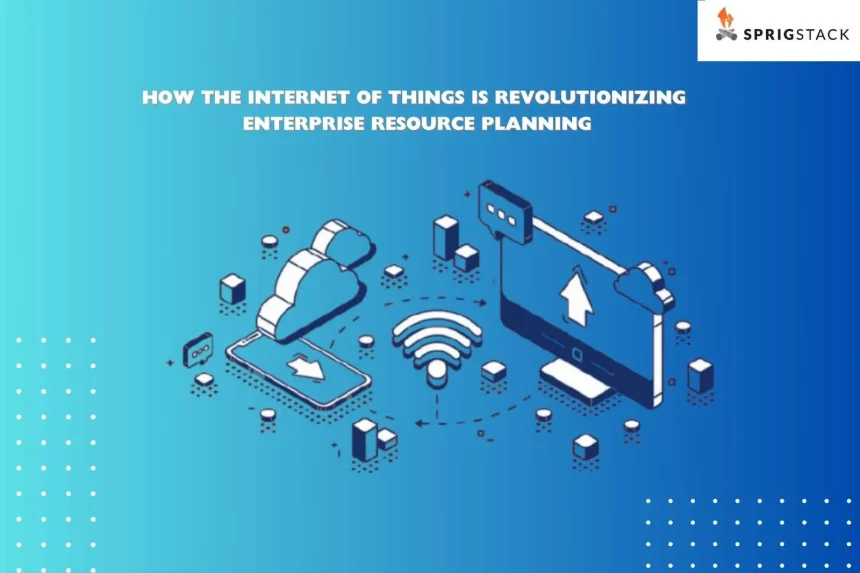The Internet of Things significantly shapes business operations in today’s constantly changing digital environment. IoT is a group of connected gadgets that gather and share data instantly. It includes computers, personal devices, industrial machines, and sensors. By using IoT in different business activities, companies can understand more, make their work easier, and create new solutions they couldn’t have thought of before. One clear example of this significant change is in Enterprise Resource Planning (ERP).
ERP systems mainly focus on essential business areas like banking, human resources, and goods management. The growth of IoT has broadened what ERP can do by allowing it to gather and analyze data in real time from goods, tools, and surroundings. To stay competitive in today’s changing market, businesses are turning to ERP development services that include IoT features. This improved visibility increases efficiency and allows companies to make quicker, data-based choices. This teamwork is a big deal. It helps us move quickly, improves how we work with suppliers, and can even tell us when equipment might fail before it does.
Let’s look at how the Internet of Things is changing ERP systems, the advantages this combination brings, and essential factors businesses should consider when using these new solutions.
Understanding the Synergy Between IoT and ERP
Systems of Enterprise Resource Planning are supposed to be the central nervous system of a company. They help to unite information from several sources onto one platform. IoT devices and sensors generate copious real-time data about how things run, their surroundings, and their use simultaneously. When these two essential ideas work together, businesses can easily use real-world data in their ERP systems.
This teamwork allows for better analysis, quick reports, and automatic processes. For instance, a production line connected to the Internet of Things (IoT) can send information about machine speeds, temperatures, or maintenance needs straight to the ERP system. Decision-makers can quickly see how well things are going and identify possible problems. In simple terms, IoT allows ERP to connect with more areas outside of a business. It provides complete insight into production, sales, and service delivery.
Real-Time Information for Enhanced Decision-Making
Real-time data availability is a significant advantage of connecting IoT devices to ERP systems. In the past, businesses often used regular data uploads and handwritten entries, which could cause delays or mistakes. IoT collects data instantly and constantly, providing a real-time view of processes.
This steady stream of information improves decision-making a lot. Managers can quickly see problems and change their plans immediately instead of waiting for monthly reports. For example, if a temperature monitor on a critical storage unit notices a rapid increase in heat. The ERP system can quickly alert the right people, start cooling processes, or replace goods to prevent damage. Companies can better forecast trends by adding IoT data to ERP dev services. They can use resources better and handle obstacles more effectively than before.
Enhanced Resource Tracking and Inventory Management
IoT devices help track resources and inventory more accurately by instantly sharing their location, state, and movement. Companies can track their items in real time by putting RFID tags or sensors on goods, containers, or tools. It helps prevent mistakes from typing data by hand or making guesses.
Being very transparent is especially helpful in industries like shopping and production, where managing inventory is essential. Connecting with the ERP system allows these sensor data to help keep stock amounts just right. They can automate restocking and lessen the chances of having too much or too little inventory. As a result, businesses can save money, make customers happier, and improve the dependability of their supply chains. It’s through ERP services—coupled with IoT integration—that businesses can adopt these advanced inventory monitoring capabilities. These can improve how well different groups work.
Predictive Maintenance and Downtime Reduction
Combining IoT with ERP has a major benefit in that it lets one forecast when a repair is required. IoT devices connected to machines or cars gather information about vibrations, temperature, pressure, and other functioning details. The system can find unusual activity or trends that might signal future problems by looking at this data over time.
With the help of IoT-powered ERP development assistance, repair plans can be created or changed automatically based on the actual state of the equipment instead of just set periods. This predictive method helps companies reduce unplanned downtime. It helps lower service costs and makes expensive machines last longer. Maintenance teams can see how well each machine is working. It helps them use their resources better and keep the business running smoothly.
Optimizing Supply Chain and Logistics
Any company that transports goods depends on excellent supply chain management. Integrating IoT with ERP can significantly enhance the awareness of the supply chain, from getting raw materials to delivering the end product. GPS monitors on delivery trucks can update the ERP system on where shipments are and when they will arrive. If there is a delay, the ERP system can quickly change the production plan or inform customers about the updates.
Also, IoT for inventory tracking helps the system predict how many goods are necessary at each place. It helps cut down on waste and keeps things restocked on time. Organizations can transition to a more effective, open, and flexible supply chain model with the help of cloud-based ERP development solutions that include IoT features. This power and understanding help companies manage their partner relationships, save money, and quickly handle problems.
Strengthening Data Security and Compliance
While IoT offers excellent opportunities, it also brings new security issues. More connected gadgets lead to more ways for hackers to break in. Keeping IoT devices, networks, and the information they produce safe is essential. When connecting IoT devices to an ERP system, businesses should use strong security, handle devices securely, and regularly check for weaknesses.
Organizations in controlled industries must ensure that their IoT-based ERP systems follow data protection laws. Modern ERP development solutions usually come with built-in legal features and upgraded security tools in these situations. A secure plan is essential to protect business assets and client trust, from encrypting IoT data to controlling access in ERP systems.
Summary
The Internet of Things has dramatically improved what standard ERP systems can do. It provides up-to-date information, forecasts, and better insight into key business activities. Businesses can better control their resources by combining IoT data with strong ERP systems. They can predict and stop problems and improve supply chains in ways that weren’t possible before. Organizations must spend on ERP development services that include IoT features to stay competitive. It’s essential, not just an option. IoT-enabled ERP systems will change businesses by allowing for predictive maintenance and making data-based decisions. It can change the way companies work from the ground up. The future of business resource planning will be connected, smart, and more flexible than ever.





